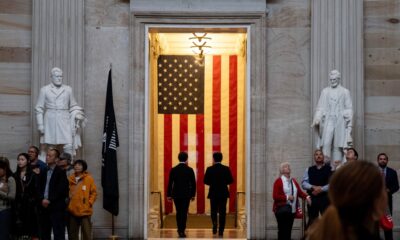Accounting
How to Mastering Accounts Receivable Management to Maximize Cash Flow
Published
6 months agoon

Effective accounts receivable (AR) management is vital for maintaining a company’s cash flow, profitability, overall financial stability and is considered to be best practice for accounting management . By implementing strategic AR practices, businesses can reduce payment delays, minimize financial risks, and improve relationships with customers. Below are in-depth strategies for enhancing AR performance, ensuring financial health, and maintaining strong client relationships.
Establishing Formal Policies and Procedures
A well-defined set of policies and procedures is the foundation of effective accounts receivable management. Clear guidelines ensure consistency across the entire order-to-cash cycle, from invoicing to collection. These guidelines should outline the specific steps involved in generating invoices, tracking payments, and handling overdue accounts. Clearly defined roles and responsibilities for team members contribute to accountability, while setting payment terms and due dates helps streamline the process.
Creating a documented standard operating procedure (SOP) that employees can refer to ensures that everyone follows the same approach, minimizing errors and reducing confusion. Policies should also specify the consequences for late payments, including any penalties or fees. Establishing escalation protocols—such as follow-up reminders, late payment notices, and legal actions if necessary—keeps the collection process organized and efficient.
Leveraging Advanced Technology for Efficiency
Incorporating technology into accounts receivable management can significantly enhance efficiency. Advanced AR software platforms offer a range of features designed to automate and optimize the process, reducing the manual workload and minimizing errors. These platforms often include automated invoicing, payment tracking, customer communication, and collections management.
Automated systems can send reminders for upcoming payments and follow up on overdue accounts without human intervention. This automation saves time and ensures consistency in communication with clients. Many platforms also offer integrated billing systems that sync with existing account receivable software, providing a seamless flow of information across financial operations. Customer portals allow clients to access statements, make payments online, and review their payment history, fostering a more convenient and user-friendly experience. Some of the best account receivable software are: QuickBooks Online, Xero, Sage Intacct and NetSuite ERP.
Implementing Regular Accounts Receivable Reviews and Aging Analyses
Regular reviews of accounts receivable are essential to maintain a healthy cash flow. Implementing a schedule for periodic AR reviews allows businesses to monitor the status of outstanding balances and identify potential problems early. Aging analyses categorize receivables based on how long they have been outstanding—30, 60, or 90+ days—highlighting overdue accounts that require immediate action. These reports are valuable tools for assessing the health of cash flow and making informed decisions about which accounts to prioritize for follow-up.
Analyzing AR data helps identify patterns and trends that may indicate broader issues, such as recurring late payments from specific clients or seasonal fluctuations in cash flow. Businesses can use this data to refine their credit policies and improve collection strategies. A disciplined review process also enables organizations to proactively address cash flow challenges before they escalate, ensuring financial stability.
Strengthening Customer Relationships for Improved Collections
Maintaining positive relationships with customers is a crucial aspect of effective AR management. Accurate and up-to-date customer information, including contact details and payment histories, enables personalized service and facilitates smoother transactions. Keeping comprehensive customer profiles with relevant data helps businesses address issues quickly and negotiate payment plans when necessary.
Clear and transparent communication builds trust with clients, making them more likely to prioritize timely payments. Sending invoices promptly, following up with friendly reminders, and providing clear payment instructions are all practices that enhance client relationships. By understanding customers’ payment behaviors and preferences, businesses can tailor their approach to improve cash flow without jeopardizing long-term partnerships.
Implementing Credit Risk Management Strategies
For companies that extend credit to customers, managing credit risk is a critical part of AR management. Implementing structured credit assessment processes allows businesses to evaluate the risk associated with each customer before offering credit terms. Conducting thorough credit checks and setting credit limits based on each client’s financial history and creditworthiness can significantly reduce the likelihood of non-payment.
Businesses should regularly review credit terms and limits to ensure they remain aligned with evolving market conditions and customer circumstances. Implementing dynamic credit policies that adapt to changes in a customer’s payment behavior or overall economic environment helps minimize risks and protect cash flow. A well-executed credit management strategy reduces the impact of late payments and uncollected debts on the company’s finances.
Utilizing Aging Reports for Strategic Analysis
Aging reports are essential tools for understanding the status of outstanding invoices. These reports categorize receivables based on the duration since the invoice was issued, making it easier to identify overdue accounts. Regularly analyzing aging reports helps businesses prioritize follow-up efforts, allocate resources effectively, and take targeted actions to minimize delinquencies.
A data-driven approach to AR management not only enhances the efficiency of collections but also provides valuable insights into the company’s financial health. Recognizing patterns in payment behavior can inform adjustments to invoicing procedures, credit policies, and follow-up strategies. Accurate and timely aging reports are crucial for maintaining cash flow and ensuring that overdue accounts are addressed promptly.
Balancing Automation with Human Oversight
While automation offers numerous benefits for accounts receivable management, human oversight remains indispensable. Automated systems excel at handling routine tasks like invoicing, sending reminders, and updating payment statuses, but they cannot replace the expertise and judgment of experienced professionals. Human involvement is necessary for analyzing data, handling complex payment disputes, and maintaining customer relationships.
Businesses should strike a balance between automation and manual oversight. Leveraging automation for repetitive tasks allows AR teams to focus on higher-value activities, such as negotiating payment plans and resolving disputes. A well-rounded approach that combines technology with human expertise ensures that AR management remains adaptable and responsive to changing circumstances.
Proactive Collections and Follow-Up Procedures
A proactive approach to collections is crucial for maintaining healthy cash flow. Sending invoices as soon as work is completed and issuing payment reminders well before the due date can significantly reduce payment delays. Establishing a structured follow-up schedule for overdue accounts—such as sending gentle reminders at 15 days and more assertive notices at 30 days—helps businesses maintain consistent cash flow.
Maintaining detailed records of all payment communications provides a clear audit trail and ensures that the collection process remains professional and well-documented. Professional yet firm follow-up procedures demonstrate the company’s commitment to timely payments while preserving the relationship with clients.
Monitoring Key Performance Indicators (KPIs) for Continuous Improvement
Tracking key performance indicators (KPIs) is essential for assessing the effectiveness of AR management strategies. Metrics such as Days Sales Outstanding (DSO), average collection period, and the percentage of overdue accounts provide valuable insights into cash flow health. Setting specific goals for these KPIs encourages continuous improvement and helps identify areas where adjustments are needed.
By regularly monitoring and analyzing these metrics, businesses can refine their AR processes, implement targeted strategies, and optimize collections. Effective AR management not only improves cash flow but also strengthens the organization’s financial foundation, supporting sustainable growth and long-term success.
Accounts receivable management services
Several reputable accounts receivable management services are available to help businesses enhance cash flow and streamline collections. TSI (Transworld Systems Inc.) specializes in customized debt collection and payment reminders, reducing delinquency rates through targeted analytics. Atradius Collections offers global AR management, focusing on credit insurance and tailored solutions for international clients. Dun & Bradstreet Receivable Management Services provides comprehensive AR solutions, including credit risk assessments and data-driven strategies. Gulf Coast Collection Bureau supports industries like healthcare and utilities with services ranging from AR outsourcing to debt recovery. ABC-Amega delivers global commercial debt collection and AR outsourcing, assisting clients in managing complex cases and reducing payment delays. These services are designed to enhance financial stability and improve payment practices across various industries.
Conclusion
Optimizing accounts receivable management is a critical step toward ensuring consistent cash flow and financial stability. By establishing clear policies, leveraging technology, conducting regular reviews, and maintaining strong customer relationships, businesses can minimize risks and improve payment efficiency. A combination of automated tools and human oversight, alongside a proactive collections strategy, allows organizations to manage their receivables effectively. Prioritizing AR management is not just about getting paid—it’s about securing the financial health and longevity of the business.
Apple iPad (10th Generation): with A14 Bionic chip, 10.9-inch Liquid Retina Display, 64GB, Wi-Fi 6, 12MP front/12MP Back Camera, Touch ID, All-Day Battery Life – Blue

Paid ads at no cost to buyer
You may like
-


Inflation rate slipped to 2.1% in April, lower than expected, Fed’s preferred gauge shows
-


German inflation May 2025
-


Trump advisor Hassett confident tariffs will stay despite judges’ ruling
-


Credit default swaps are in demand again amid U.S. fiscal worries
-


Elon Musk says Trump’s spending bill undermines the work DOGE has been doing
-


Trump hails ‘positive’ step in U.S.-EU trade talks as markets await deal


The American Institute of CPAs is asking leaders of the Senate Finance Committee and the House Ways and Means Committee to make changes in the wide-ranging tax and spending legislation that was
In a
“While we support portions of the legislation, we do have significant concerns regarding several provisions in the bill, including one which threatens to severely limit the deductibility of state and local tax (SALT) by certain businesses,” wrote AICPA Tax Executive Committee chair Cheri Freeh in the letter. “This outcome is contrary to the intentions of the One Big Beautiful Bill Act, which is to strengthen small businesses and enhance small business relief.”
The AICPA urged lawmakers to retain entity-level deductibility of state and local taxes for all pass-through entities, strike the contingency fee provision, allow excess business loss carryforwards to offset business and nonbusiness income, and retain the deductibility of state and local taxes for all pass-through entities.
The proposal goes beyond accounting firms. According to the
The AICPA argued that SSTBs would be unfairly economically disadvantaged simply by existing as a certain type of business and the parity gap among SSTBs and non-SSTBs and C corporations would widen.
Under current tax law (and before the passage of the Tax Cuts and Jobs Act of 2017), it noted, C corporations could deduct SALT in determining their federal taxable income. Prior to the TCJA, owners of PTEs (and sole proprietorships that itemized deductions) were also allowed to deduct SALT on income earned by the PTE (or sole proprietorship).
“However, the TCJA placed a limitation on the individual SALT deduction,” Freeh wrote. “In response, 36 states (of the 41 that have a state income tax) enacted or proposed various approaches to mitigate the individual SALT limitation by shifting the SALT liability on PTE income from the owner to the PTE. This approach restored parity among businesses and was approved by the IRS through Notice 2020-75, by allowing PTEs to deduct PTE taxes paid to domestic jurisdictions in computing the entity’s federal non-separately stated income or loss. Under this approved approach, the PTE tax does not count against partners’/owners’ individual federal SALT deduction limit. Rather, the PTE pays the SALT, and the partners/owners fully deduct the amount of their distributive share of the state taxes paid by the PTE for federal income tax purposes.”
The AICPA pointed out that C corporations enjoy a number of advantages, including an unlimited SALT deduction, a 21% corporate tax rate, a lower tax rate on dividends for owners, and the ability for owners to defer income.
“However, many SSTBs are restricted from organizing as a C corporation, leaving them with no option to escape the harsh results of the SSTB distinction and limiting their SALT deduction,” said the letter. “In addition, non-SSTBs are entitled to an unfettered qualified business income (QBI) deduction under Internal Revenue Code section 199A, while SSTBs are subject to harsh limitations on their ability to claim a QBI deduction.”
The AICPA also believes the bill would add significant complexity and uncertainty for all pass-through entities, which would be required to perform complex calculations and analysis to determine if they are eligible for any SALT deduction. “To determine eligibility for state and local income taxes, non-SSTBs would need to perform a gross receipts calculation,” said the letter. “To determine eligibility for all other state and local taxes, pass-through entities would need to determine eligibility under the substitute payments provision (another complex set of calculations). Our laws should not discourage the formation of critical service-based businesses and, therefore, disincentivize professionals from entering such trades and businesses. Therefore, we urge Congress to allow all business entities, including SSTBs, to deduct state and local taxes paid or accrued in carrying on a trade or business.”
Tax professionals have been hearing about the problem from the Institute’s outreach campaign.
“The AICPA was making some noise about that provision and encouraging some grassroots lobbying in the industry around that provision, given its impact on accounting firms,” said Jess LeDonne, director of tax technical at the Bonadio Group. “It did survive on the House side. It is still in there, specifically meaning the nonqualifying businesses, including SSTBs. I will wait and see if some of those efforts from industry leaders in the AICPA maybe move the needle on the Senate side.”
Contingency fees
The AICPA also objects to another provision in the bill involving contingency fees affecting the tax profession. It would allow contingency fee arrangements for all tax preparation activities, including those involving the submission of an original tax return.
“The preparation of an original return on a contingent fee basis could be an incentive to prepare questionable returns, which would result in an open invitation to unscrupulous tax preparers to engage in fraudulent preparation activities that takes advantage of both the U.S. tax system and taxpayers,” said the AICPA. “Unknowing taxpayers would ultimately bear the cost of these fee arrangements, since they will have remitted the fee to the preparer, long before an assessment is made upon the examination of the return.”
The AICPA pointed out that contingent fee arrangements were associated with many of the abuses in the Employee Retention Credit program, in both original and amended return filings.
“Allowing contingent fee arrangements to be used in the preparation of the annual original income tax returns is an open invitation to abuse the tax system and leaves the IRS unable to sufficiently address this problem,” said the letter. “Congress should strike the contingent fee provision from the tax bill. If Congress wants to include the provision on contingency fees, we recommend that Congress provide that where contingent fees are permitted for amended returns and claims for refund, a paid return preparer is required to disclose that the return or claim is prepared under a contingent fee agreement. Disclosure of a contingent fee arrangement deters potential abuse, helps ensure the integrity of the tax preparation process, and ensures compliance with regulatory and ethical standards.”
Business loss carryforwards
The AICPA also called for allowing excess business loss carryforwards to offset business and nonbusiness income. It noted that the One Big Beautiful Bill Act amends Section 461(l)(2) of the Tax Code to provide that any excess business loss carries over as an excess business loss, rather than a net operating loss.
“This amendment would effectively provide for a permanent disallowance of any business losses unless or until the taxpayer has other business income,” said letter. “For example, a taxpayer that sells a business and recognizes a large ordinary loss in that year would be limited in each carryover year indefinitely, during which time the taxpayer is unlikely to have any additional business income. The bill should be amended to remove this provision and to retain the treatment of excess business loss carryforwards under current law, which is that the excess business loss carries over as a net operating loss (at which point it is no longer subject to section 461(l) in the carryforward year).
AICPA supports provisions
The AICPA added that it supported a number of provisions in the bill, despite those concerns. The provisions it supports and has advocated for in the past include
• Allow Section 529 plan funds to be used for post-secondary credential expenses;
• Provide tax relief for individuals and businesses affected by natural disasters, albeit not
permanent;
• Make permanent the QBI deduction, increase the QBI deduction percentage, and expand the QBI deduction limit phase-in range;
• Create new Section 174A for expensing of domestic research and experimental expenditures and suspend required capitalization of such expenditures;
• Retain the current increased individual Alternative Minimum Tax exemption amounts;
• Preserve the cash method of accounting for tax purposes;
• Increase the Form 1099-K reporting threshold for third-party payment platforms;
• Make permanent the paid family leave tax credit;
• Make permanent extensions of international tax rates for foreign-derived intangible income, base erosion and anti-abuse tax, and global intangible low-taxed income;
• Exclude from GILTI certain income derived from services performed in the Virgin
Islands;
• Provide greater certainty and clarity via permanent tax provisions, rather than sunset
tax provisions.
Accounting
On the move: HHM promotes former intern to partner
Published
18 hours agoon
May 30, 2025

KPMG anoints next management committee; Ryan forms Tariff Task Force; and more news from across the profession.
Accounting
Mid-year moves: Why placed-in-service dates matter more than ever for cost segregation planning
Published
19 hours agoon
May 30, 2025

In the world of depreciation planning, one small timing detail continues to fly under the radar — and it’s costing taxpayers serious money.
Most people fixate on what a property costs or how much they can write off. But the placed-in-service date — when the IRS considers a property ready and available for use — plays a crucial role in determining bonus depreciation eligibility for cost segregation studies.
And as bonus depreciation continues to phase out (or possibly bounce back), that timing has never been more important.
Why placed-in-service timing gets overlooked
The IRS defines “placed in service” as the moment a property is ready and available for its intended use.
For rentals, that means:
- It’s available for move-in, and,
- It’s listed or actively being shown.
But in practice, this definition gets misapplied. Some real estate owners assume the closing date is enough. Others delay listing the property until after the new year, missing key depreciation opportunities.
And that gap between intent and readiness? That’s where deductions quietly slip away.
Bonus depreciation: The clock is ticking
Under current law, bonus depreciation is tapering fast:
- 2024: 60%
- 2025: 40%
- 2026: 20%
- 2027: 0%
The difference between a property placed in service on December 31 versus January 2 can translate into tens of thousands in immediate deductions.
And just to make things more interesting — on May 9, the House Ways and Means Committee released a draft bill that would reinstate 100% bonus depreciation retroactive to Jan. 20, 2025. (The
The result? Accountants now have to think in two timelines:
- What the current rules say;
- What Congress might say a few months from now.
It’s a tricky season to navigate — but also one where proactive advice carries real weight.
Typical scenarios where timing matters
Placed-in-service missteps don’t always show up on a tax return — but they quietly erode what could’ve been better results. Some common examples:
- End-of-year closings where the property isn’t listed or rent-ready until January.
- Short-term rentals delayed by renovation punch lists or permitting hang-ups.
- Commercial buildings waiting on tenant improvements before becoming operational.
Each of these cases may involve a difference of just a few days — but that’s enough to miss a year’s bonus depreciation percentage.
Planning moves for the second half of the year
As Q3 and Q4 approach, here are a few moves worth making:
- Confirm the service-readiness timeline with clients acquiring property in the second half of the year.
- Educate on what “in service” really means — closing isn’t enough.
- Create a checklist for documentation: utilities on, photos of rent-ready condition, listings or lease activity.
- Track bonus depreciation eligibility relative to current and potential legislative shifts.
For properties acquired late in the year, encourage clients to fast-track final steps. The tax impact of being placed in service by December 31 versus January 2 is larger than most realize.
If the window closes, there’s still value
Even if a property misses bonus depreciation, cost segregation still creates long-term savings — especially for high-income earners.
Partial-year depreciation still applies, and in some cases, Form 3115 can allow for catch-up depreciation in future years. The strategy may shift, but the opportunity doesn’t disappear.
Placed-in-service dates don’t usually show up on investor spreadsheets. But they’re one of the most controllable levers in maximizing tax savings. For CPAs and advisors, helping clients navigate that timing correctly can deliver outsized results.
Because at the end of the day, smart tax planning isn’t just about what you buy — it’s about when you put it to work.

How to save on summer travel in 2025

Denmark raises retirement age to 70; U.S. might follow

AICPA wants Congress to change tax bill

New 2023 K-1 instructions stir the CAMT pot for partnerships and corporations

The Essential Practice of Bank and Credit Card Statement Reconciliation

Are American progressives making themselves sad?
Trending
-

 Accounting1 week ago
Accounting1 week agoHouse tax bill includes provision eliminating PCAOB
-

 Economics1 week ago
Economics1 week agoWhat happens if the Inflation Reduction Act goes away?
-

 Personal Finance1 week ago
Personal Finance1 week agoWhat House Republican ‘big beautiful’ budget bill means for your money
-

 Accounting1 week ago
Accounting1 week agoTrump tax bill faces Senate’s arcane rules, desire for changes
-

 Finance1 week ago
Finance1 week agoPersonal finance app Monarch raises $75 million
-

 Economics1 week ago
Economics1 week agoHow much worse could America’s measles outbreak get?
-

 Economics1 week ago
Economics1 week agoA court resurrects the United States Institute of Peace
-

 Economics1 week ago
Economics1 week agoCalifornia has got really good at building giant batteries
